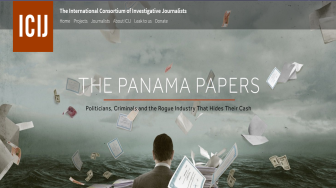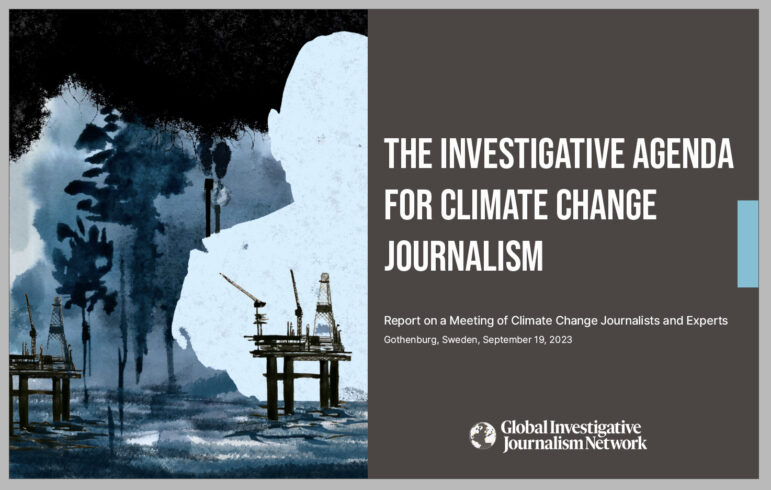

Panama Papers Showcase Power of a Global Movement
The ongoing and spectacular investigation “Panama Papers” represents the culmination of a significant shift in the way journalism is now practiced.
The project, by the International Consortium of Investigative Journalists and nearly 400 colleagues from 107 outlets, also represents the result of 40 years of
work done by groups of investigative reporters to bring the profession into the 21st Century.
 The elements of the new journalism include:
The elements of the new journalism include:
- Collaboration, both on small and large scales;
- Increased sophistication in data analysis and ability to handle large datasets;
- The rise of nonprofit journalism allowing journalists to focus on in-depth investigations;
- The advent of the Internet, which has led to easier communication and collaboration;
- Rapid globalization spurred by the communications and information revolutions;
- The end of the Cold War and increased global mobility;
- The global spread of investigative journalism, spurred by professional groups and conferences, commercial media, international aid programs, and universities.
“The Panama Papers showcases not so much technological power but the power of the global investigative reporting movement,” says Sheila Coronel, co-founder and former executive director of the Philippine Center for Investigative Journalism and now dean of academic affairs at the Columbia Journalism School.
Conferences, workshops, and collaborations, Coronel noted, have “fostered camaraderie and trust among investigative reporters in different parts of the world. The bonds of professional solidarity that have been formed made the Panama Papers possible. “
The shift actually began in the mid-1970s with creation of the U.S.-based Investigative Reporters and Editors (IRE), now a 5,000 member association, and the founding of the original Center for Investigative Reporting. Both were based on the idea of collaboration, whether among reporters or organizations.

The Arizona Project, 1976: Nearly 40 journalists from 23 outlets teamed up to tell the Mafia you can’t kill journalists. Credit: Investigative Reporters and Editors.
IRE early on showcased the power of collaboration in The Arizona Project, where dozens of journalists from news organizations around the United States gathered in Phoenix, Arizona, in response to the murder of journalist Don Bolles. The group published a 23-part series that detailed the government corruption and organized crime activity that Bolles had been covering. The project helped inspire other group investigations and the creation of IRE-like associations throughout the world.
It is little known that the Arizona Project also included data analysis in the form of social network analysis, perhaps the first time it was used in journalism. The leaders of the project hired a university professor to connect the dots among the so-called Phoenix 40, a group of government and business leaders who privately set the agenda for the city.
During the 1980s, data journalism began to be used more and more in the U.S. until various educational programs coalesced at IRE in the form of the National Institute for Computer-Assisted Reporting, which started in 1994 as a successor to another program at IRE’s University of Missouri headquarters.

A Global Movement: Some of the 130 investigative journalism nonprofits now in 50 countries.
Since that time, NICAR has taught thousands of journalists how to do data analysis while constantly updating its curriculum. NICAR instructors, graduate students who worked in the NICAR data library, and NICAR workshop and conference attendee now practice data analysis throughout the journalism world. (Indeed, long-time NICAR instructor David Donald later worked at the Center for Public Integrity and dealt with the first datasets leaked to the International Consortium of Investigative Journalists.)
NICAR spawned many other data journalism training programs in other countries as it showed journalists how to integrate data into reporting and how to teach others how to do it.
At the same time, the idea of an independent nonprofit newsroom devoted to investigative reporting caught on, both in the U.S. and overseas. Founded in 1977 in the San Francisco Bay Area, the Center for Investigative Reporting demonstrated to private foundations that investigative journalism could have major policy impact. Its staff, made up of freelance journalists, broke important new ground investigating environmental polluters, the nuclear arms race, organized crime, and consumer health issues.
In 1989, a similarly structured nonprofit, the Center for Public Integrity, was founded in Washington, D.C. That same year, groups in Scandinavia launched IRE-like associations to strengthen watchdog reporting there, while the first investigative reporting nonprofit began in a developing country, the Philippine Center for Investigative Journalism.
With the fall of the Berlin Wall in 1989, millions of dollars in Western aid poured into former Communist nations, working to build up an independent press. Investigative journalism groups, backed by international assistance, sprouted up in Armenia, Bosnia, Romania, and elsewhere. Many are still in existence, and some have played key roles in the Panama Papers project.
At the Center for Public Integrity, founder Charles Lewis in 1997 created an international network of award-winning journalists to tackle cross-border issues, dubbed the International Consortium of Investigative Journalists, or ICIJ.
Under its first editor, AP veteran Maud Beelman, ICIJ showed in its earliest years the value of collaboration in a globalizing world, uniting journalists from a dozen countries in focused projects on the tobacco industry, the arms trade, and more. Beelman was succeeded by another seasoned editor, David Kaplan, who expanded ICIJ’s reach to media partners in 20 countries, taking on the fishing, asbestos, and energy industries.
Their efforts would lay the groundwork for the next generation of ICIJ staff, led by Gerard Ryle and Marina Walker Guevara. Aided by secure collaborative platforms, encrypted communications, and massive leaks, today’s ICIJ would manage a team of journalists reaching into an extraordinary 80 countries to produce the Panama Papers.
Many of the original ICIJ members were alumni of U.S. journalism fellowships, like the Niemans at Harvard and the Knights at Stanford. Dozens more award-winning journalists from over 65 countries were added over the years. Mainstream media increasingly joined ICIJ’s projects, particularly outside the U.S., as the loss of ad revenue and audience weakened traditional newsrooms.
Also key was the global spread of the nonprofit model pioneered by IRE, CIR, and others. By 2007, there were 39 nonprofit investigative journalism groups in 26 countries, with more than half of those founded since 2000, according to the Center for International Media Assistance. A follow-up 2012 survey found that number had more than doubled, to 106 nonprofits in 47 countries. Today, the number is more than 130 worldwide.
With the support of foundations, private donors, international assistance agencies, and the enterprise of the journalists themselves, these groups have become a global movement of newsrooms independent of government or corrupt publishers.
It is no accident that more than a quarter of the 107 partner organizations in the Panama Papers are nonprofits that have emerged from this movement.
 Another key factor in this build-up of nonprofit newsrooms has been the Global Investigative Journalism Network, which held its first conference in 2001 in Copenhagen, drawing more than 300 journalists from 40 countries. Since then, GIJN has held ten international conferences and trained thousands of journalists in investigative reporting and data analysis. It has become a global hub for the world’s muckrakers and served as a catalyst for the formation of nonprofit newsrooms and cross-border collaboration.
Another key factor in this build-up of nonprofit newsrooms has been the Global Investigative Journalism Network, which held its first conference in 2001 in Copenhagen, drawing more than 300 journalists from 40 countries. Since then, GIJN has held ten international conferences and trained thousands of journalists in investigative reporting and data analysis. It has become a global hub for the world’s muckrakers and served as a catalyst for the formation of nonprofit newsrooms and cross-border collaboration.
So when the Panama Papers were leaked there awaited a coordinating organization, networks of journalists and newsrooms that had learned to work with and trust each other, a high level of expertise in traditional and data journalism built up through conferences and workshops, and donors to support all of it – a determined building of a global movement of public-interest investigative reporting.
The Panama Papers shows that the shift has been made and is a milestone on this road to a form of investigative journalism that meets the challenges of a world of overwhelming data and international schemes.
Says Coronel: “The age of the lone wolf is over.”
Brant Houston is Knight Chair in Investigative Reporting at the University of Illinois. He is co-founder and board chair of the Global Investigative Journalism Network and served for ten years as executive director of Investigative Reporters and Editors. He has taught and spoken about investigative and computer-assisted reporting at newsrooms and universities in 25 countries. @branthouston
Graphic credit at top: Organization for Economic Co-operation and Development.










